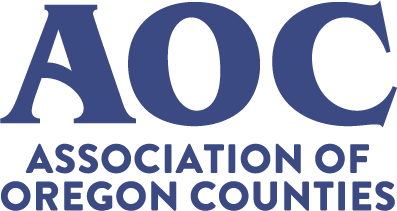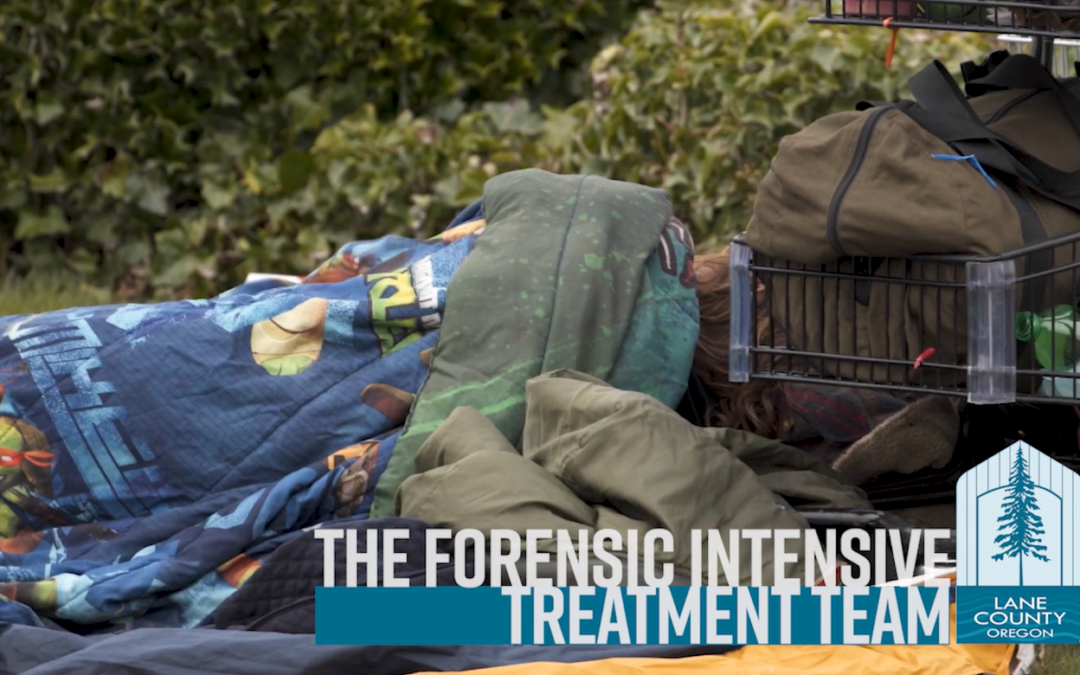
Jun 28, 2024 | County News, Health & Human Services
Lane County is taking steps toward developing a Law Enforcement Assisted Diversion (LEAD®) model deflection program in response to the new misdemeanor for drug possession that is effective September under House Bill 4002. The program aims to redirect individuals struggling with addiction and mental health issues away from the criminal justice system and into appropriate treatment and support services. Lane County has secured half of the $1.9 million needed to develop the program and aims to launch it by the end of the year.
To spearhead this program, Lane County has appointed Clint Riley as the program coordinator. Riley, who recently retired as Lane County Sheriff’s Office Jail Commander, brings a wealth of experience from his long career in law enforcement. He has witnessed the profound impact of addiction and mental health problems firsthand and is acutely aware of the urgent need for alternative solutions. “The jail is the one size fits all system right now, but we need to have several other systems for law enforcement to use. I see a lot of people get stuck in the system because of addiction and mental health challenges. A deflection program will give police a place to put them instead of in jails or the emergency room,” Riley said.
However, Lane County faces several challenges in meeting the community’s needs. There is a pressing need for more staff to provide peer support and treatment, additional beds for those in need, and logistical solutions to serve the large geographical area spanning from the coast to the Cascade Mountains. Lane County is also grappling with a high rate of overdose deaths, one of the highest in Oregon, according to Riley, alongside a substantial unhoused population.
Unlike Marion County’s LEAD® program, which is managed by the sheriff’s office, Lane County’s program will be operated by the Community Justice and Rehabilitation Services Department. Regular meetings are being held with various stakeholders, including law enforcement agencies, the courts, the district attorney, and behavioral health agencies, to tailor a program that addresses the specific needs of the Lane County community.
The deflection program will complement existing services such as FITT (Forensic Intensive Treatment Team) and CAHOOTS (Crisis Assistance Helping Out On The Streets). CAHOOTS, a well-known service in Eugene and Springfield for over thirty years, provides mobile crisis intervention, whereas FITT is designed to offer intensive clinical care, case management, and peer support to individuals who frequently use jail, hospital, or institutional placement systems. Funded by the IMPACTS (Improving People’s Access to Community-Based Treatment, Support, and Services) grant from the Oregon Criminal Justice Commission, FITT focuses on delivering wraparound care, including mental health and substance use treatment, to high-need individuals.
The strategic goal of these programs is proactive engagement — reaching individuals before they reach a crisis point, thereby preventing their entry or re-entry into the criminal justice system. By meeting clients where they are and bringing services directly to them, these initiatives aim to build meaningful connections and relationships with those who are often caught in a cycle of crisis and institutionalization.
“The opportunity to create a new program that has the potential to save lives by connecting people facing substance use issues to the right home for their needs is one we are taking very seriously,” said Lane County Board of County Commissioners Chair Laurie Trieger. “It is energizing to work with a wide range of community partners to imagine new ways to help people. If we do this right, we can not only help people suffering with substance abuse issues, but improve the lives of their loved ones and the community at large, too.”
Contributed by: Erin Good | Communications Coordinator
This is the second article in AOC’s series on counties setting up deflection programs. Read the previous article about Marion County: County Deflection Programs | Marion County Law Enforcement Assisted Diversion (LEAD®) Program
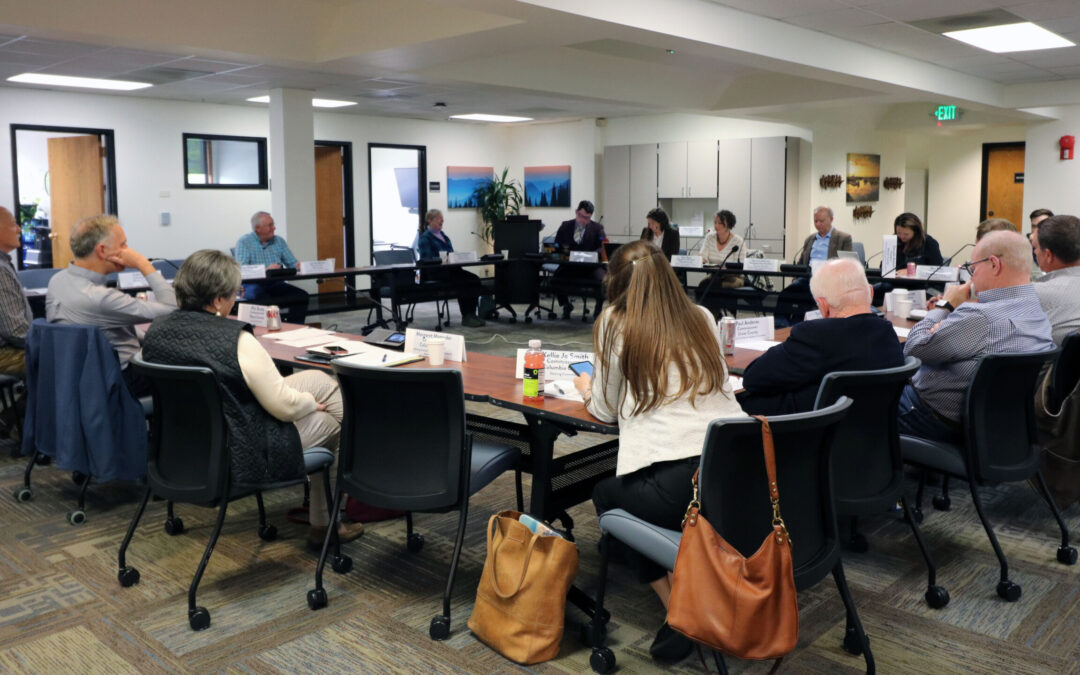
Jun 27, 2024 | AOC Advocacy, AOC News, Legislative Committee
The Association of Oregon Counties (AOC) policy steering committees met June 17-18, to deliberate and make recommendations to the AOC Legislative Committee for the short list of top-priority policy objectives for the 2025 Oregon State Legislative session. The AOC Legislative Committee ultimately adopted five priorities, which make up the 2025 AOC Policy Priority Platform (View PDF). The following priorities all speak to AOC’s overarching state-county partnership goal – counties provide essential public services to all Oregonians and must be supported by adequate resources and appropriate authority.
Governance and Revenue
- Sustain and protect the property tax asset to the benefit of all property owners and taxing districts through adequate, equitable, and stable funding for county assessment and taxation programs.
Health and Human Services
- Provide counties with the resources to address Oregon’s addiction and homelessness crises by removing administrative burdens and funding county public health and behavioral health services, deflection programs, and local homelessness response coordination for youth and adults.
Natural Resources
- Protect and strengthen county authority, funding, and flexibility in managing local natural resource policies.
Public Safety
- Fully fund a revised community corrections formula that accurately reflects the costs incurred by counties.
Transportation
- Ensure a comprehensive transportation funding package prioritizes investments in operations, maintenance, and safety; incorporates diverse and modern funding mechanisms to ensure the growth and stabilization of the State Highway Fund (SHF); maintains the 30% county share of SHF revenues; and reduces barriers to local revenue sources.
Over 30 hours of steering committee meetings, held between April and June, informed these priorities. State agency directors, Governor Kotek’s policy staff, state agency commission chairs, and stakeholder partners joined our members for deep dives into the issues facing Oregon’s 36 counties. Throughout these meetings, AOC steering committees identified the most pressing items with a direct impact on county governance, budgets, and services. The AOC Legislative Affairs Department will engage on hundreds of bills with potential impacts to counties during the 2025 session and will continue to bring issues forward to our membership through the AOC policy process. The next AOC day will be Monday, Sept. 9, with steering committees also meeting on Friday, Sept. 6. Stay updated on all AOC meetings and events with the calendar on AOC’s website.
Contributed by: Mallorie Roberts | Legislative Affairs Director
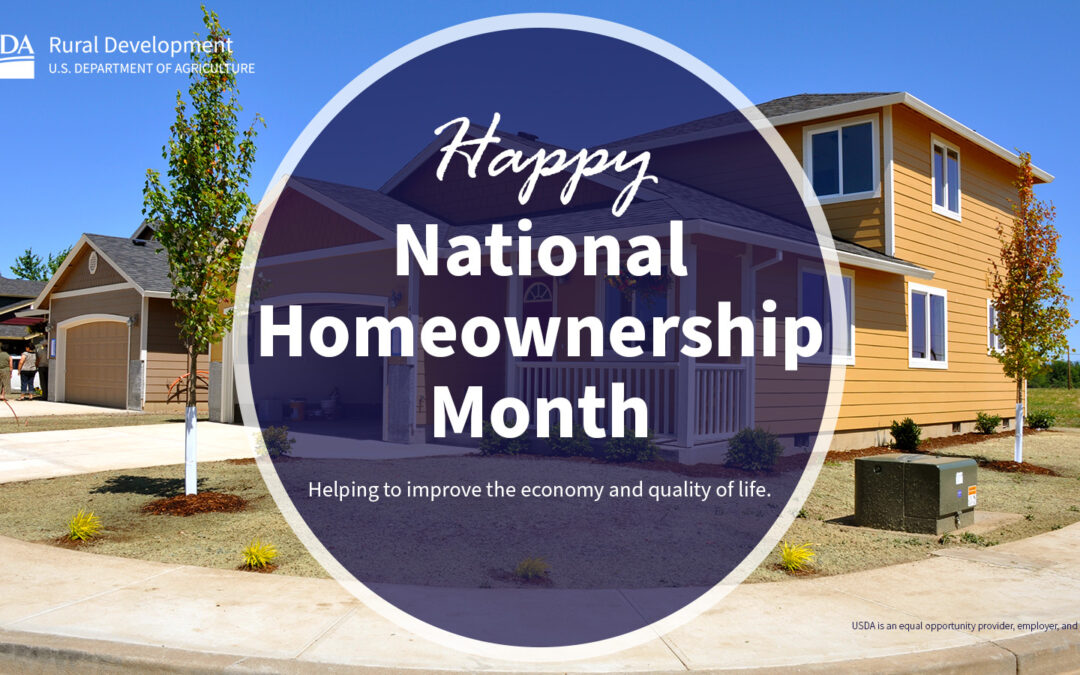
Jun 27, 2024 | AOC Business Partner
Sponsored content contributed by AOC Business Partner: USDA Rural Development
Last month was National Homeownership Month, and after 75 years helping rural Oregonians, USDA Rural Development (USDA RD) has a lot to celebrate and even more work to do. Every year, hundreds of families in rural Oregon buy, build, and repair homes using USDA loans, loan guarantees, and grants, but USDA Rural Development programs also can help whole communities rehabilitate existing property or start fresh from the ground up.
Many of Oregon’s rural communities have seen impressive population growth over the past few years, and with new faces comes a need for new housing. Unfortunately, before new housing can be built, communities must address aging or strained infrastructure. USDA RD’s Water and Environmental Programs provide loans, loan guarantees, and grants for major water projects as well as grants for communities facing the aftermath of or preparing for a disaster like a chemical spill, landslide, or drought. USDA RD also provides financing for electric projects, including renewable energy, and broadband projects, including telemedicine and distance learning. Additionally, USDA RD’s Rural Housing Site loans can be used to acquire and develop single family housing sites for low or moderate-income families.
For some communities, the best way to increase housing supply is to repair or maintain existing homes. USDA RD’s Housing Preservation Grants allow local government entities and Tribes to repair or rehabilitate housing owned by low or very low-income homeowners. Rental owners may also be eligible. Using the funding, applicants can administer grants or low-interest loans so that homeowners can install handicap accessibility features, repair rooves, fix septic tanks, and more. USDA RD’s Rural Energy Savings Program also provides funding for qualified entities that provide energy efficiency loans to qualified customers, which can be used for weatherization, home energy upgrades, and more.
Sometimes it’s difficult to know where to start with large housing projects. Sometimes communities need technical assistance to plan out transitional or supportive housing. USDA RD’s Community Facilities Technical Assistance Grants help fund technical assistance from the Housing Assistance Council, so communities can access the support they need before breaking ground, or help public bodies provide technical assistance funding for eligible projects. Similarly, the Community Facilities Guaranteed Loan program can help public bodies and qualified lenders finance community, social, public, or cultural centers and other essential community infrastructure for residents to help make new housing feel like home.
Whatever stage your housing project is in, contact USDA RD at (503) 414-3300 or locate your nearest office for assistance. The sooner federal agencies get involved, the faster they can lend support, answer questions, and help with capacity issues. After all, when rural Oregon prospers, all of Oregon prospers.
Contributed by: Max Sprague | United States Department of Agriculture Rural Development
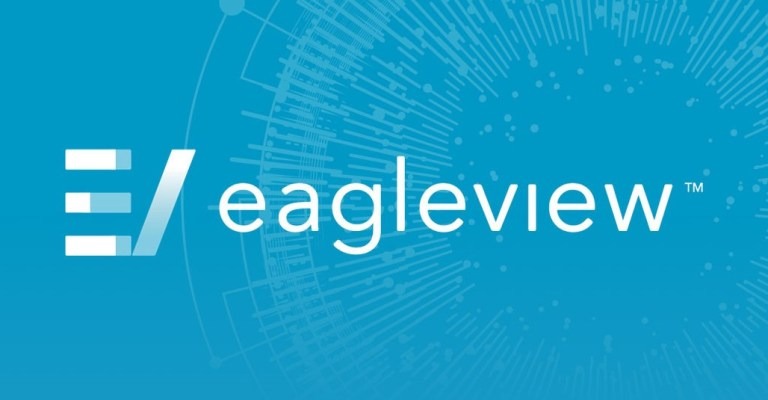
Jun 27, 2024 | AOC Business Partner
Sponsored content contributed by AOC Business Partner: EagleView
In today’s fast-paced world, the accuracy and detail of geographic data can be the difference between adequate and exceptional in terms of planning, management, and disaster response. For county governments across Oregon, accessing high-resolution aerial imagery is not just an enhancement but a necessity. Among the most transformative advancements in this area is 1-inch Ground Sample Distance (GSD) aerial imagery, which offers unprecedented clarity and detail.
One-inch GSD imagery represents the distance on the ground each pixel covers, meaning each pixel in a 1-inch GSD image represents a 1-inch square on the ground. This level of detail provides a nearly microscopic view of assets, structures, and features, allowing for more precise assessments and informed decision-making. It transforms the typical guesswork associated with lower resolutions into precise, reliable knowledge of ground conditions.
Enhanced Property Assessment
For property assessors, the detail offered by 1-inch GSD imagery is invaluable. This technology allows for a clearer understanding of property features such as building conditions, land use, and even the type of siding. In Oregon, where diverse landscapes from coastal regions to urban centers present unique challenges, such precise imagery enables more accurate property value assessments and fairer taxation.

Increased Data, Increased Efficiency
With 1-inch GSD imagery, the amount of data and information available is significantly higher than that of lower resolutions. For example, a single pixel of 1-inch GSD imagery contains nine times as much detail as a pixel of 3-inch GSD imagery. This increase in data not only enhances the visual clarity but also reduces the need for frequent site visits. Knowing exactly what’s on the ground through imagery means fewer trips, which increases productivity, saves money, and enhances safety for field personnel.
Improved Planning, Development, and Asset Management
Urban and regional planners benefit greatly from high-resolution aerial imagery. With 1-inch GSD, planners can conduct thorough site analyses without the need for extensive field visits, saving time and resources. This imagery supports the design and implementation of development projects with a high degree of precision, ensuring that every detail is considered—from environmental impacts to zoning compliance. Take this example for asset management. On the left you can tell it’s a speed limit sign but can’t confidently read it. On the right, it clearly reads “Speed Limit 35.” This keeps someone from having to visit the sign to verify asset inventory, and when you’re managing hundreds of thousands of signs, those time, cost, and efficiency savings add up.
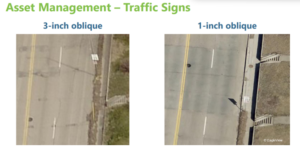
Effective Disaster Management
The clarity of 1-inch GSD imagery proves critical in disaster management. Following events like wildfires or floods, it’s crucial for response teams to have detailed visual data to assess damage and strategize recovery efforts effectively. The 2023 Gray fire in Washington showcased how detailed aerial imagery could aid in rapid assessment and help manage the aftermath efficiently, facilitating quicker recovery and minimizing economic impacts.
Encouraging Adoption
Despite its benefits, the adoption of 1-inch GSD imagery among county governments has been varied. Cost and technical requirements can be barriers. However, the return on investment, in terms of enhanced accuracy, time savings, and improved outcomes, often outweighs these initial challenges. As more counties experience and share their success stories, the momentum for embracing this technology continues to grow.
1-inch GSD aerial imagery is not just a tool but a game-changer for county governments in Oregon. It empowers counties to perform better in every facet of their responsibilities, from assessment to emergency response. As we continue to advocate for and invest in these technologies, the scope for their application expands, promising not only to meet but exceed the modern demands of county governance.
Contact Ruth Zipfel, ruth.zipfel@eagleview.com, for a demo to see how 1-inch GSD imagery can transform the way you work.
Contributed by: Megan Reilly, EagleView
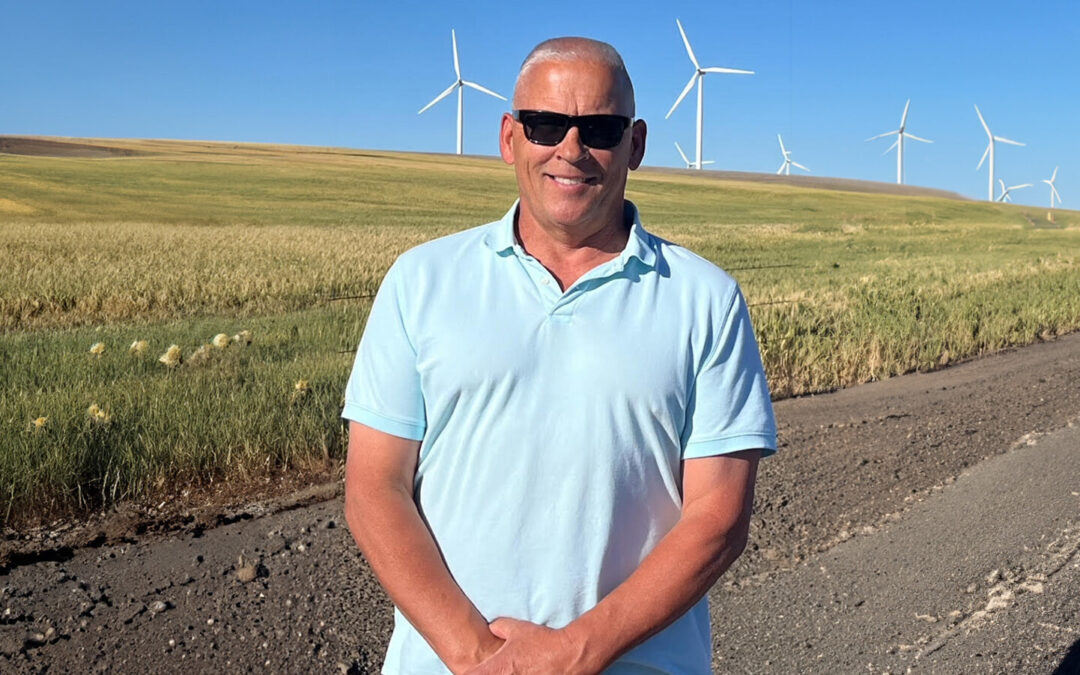
Jun 27, 2024 | AOC Business Partner
Sponsored content contributed by AOC Business Partner: Community Renewable Energy Association (CREA)
Due to the threat of climate change and the need to decarbonize our sources of power, Oregon (alongside other west coast states) has adopted aggressive laws and policies to move toward electrification from renewable sources. The latest in Oregon is HB 2021 which set targets for decarbonizing the electricity supply by 2040. Oregon counties began to experience this transition firsthand around the turn of this century with the first “wind boom” on the Columbia Plateau.
Gilliam, Sherman, and Morrow counties are the leading producers of renewable energy in the state (#1 depends on what you count: Sherman is #1 if the John Day Dam is included, or if just wind and solar, Gilliam leads with Morrow gaining fast).
Now, we’re experiencing the second rush for siting projects to meet the legislative goals. For example, Sherman County, which has a little over 1259 MW of wind and solar generation capacity currently is targeted for over 15,000 MW of proposed new generation based on known requests to interconnect to the BPA grid. These projects are limited by the lack of transmission capacity which, unfortunately, has a long lead time for upgrade. The developers are often large multinational corporations with access to the immense capital needed to fund and build the projects. The customers are primarily the investor-owned utilities (IOUs) who serve the load in the population centers along the I-5 corridor. Most of rural Oregon is served by consumer owned utilities (COUs) who get their power largely or entirely from hydropower and some nuclear power.
The investor-owned utilities in Oregon subject to the requirements of HB 2021 must file with the Oregon Public Utility Commission a plan for acquiring new resources (Integrated Resource Plan or IRP and a Clean Energy Plan or CEP) and then must seek those resources either by contracting for them or building them through their Request for Proposal (RFP) solicitation. After a long period of flat load growth due to measures like conservation and some distributed generation (like rooftop solar) load growth is now increasing at over 10% a year. General electrification, the demand from new data centers and increased numbers of electric vehicles are large factors in this growth as well.
There is no requirement that these renewable energy projects to become carbon neutral by 2040 get built in Oregon. However, we’ve seen significant benefits for those counties where projects have been located. These projects grow the property tax base and provide employment opportunities and can help make the area more energy resilient in times of need. Twenty years ago Sherman and Gilliam were near the bottom in per capita income of Oregon counties, now both are near the top (Sherman 4th, Gilliam 6th in recent statistics). Counties are also able to negotiate Community Benefits Agreements (CBAs) which have become standard as a requirement for siting and in property tax incentive negotiations. These CBAs can range and are negotiated based on the needs of the local community.
The IOUs operating in Oregon are often motivated to obtain resources from other states where wind and solar resources are somewhat better and can be cheaper to build. The IOUs often cite “protecting the rate payer” as the reasoning for this strategy. But ratepayers are also taxpayers (directly or indirectly) and an increased property tax base means more revenue for schools and public safety as we have seen throughout Eastern Oregon where most of the utility scale projects are being built. Building projects out of state means Oregon will lose out on the local community benefits that include jobs, taxes, other financial agreements, and energy resiliency.
CREA, an ORS 190 intergovernmental entity, advocates on behalf of Oregon local governments and energy developers in support of policies favorable for local renewable energy development. Our members include primarily counties but also cities, irrigation districts and a port. CREA also has members from the development community who help the organization and its members understand the industry and the challenges. We try to stay abreast of new technologies and issues arising from renewable energy development such as green hydrogen, geothermal, offshore wind, nuclear and storage solution (batteries & pumped hydro).
CREA meetings are public and virtual. We welcome participation and membership from all Oregon counties and local governments.
Contributed by: Sherman County Judge Joe Dabulskis, CREA chair
CREA is an ORS 190 intergovernmental association. Members include counties, irrigation districts, project developers, for-profit businesses and non-profit organizations. CREA supports business and economic opportunities through renewable energy development in a competitive environment. We support the use of free enterprise principles to create economically and environmentally responsible electric generation within the State of Oregon.

